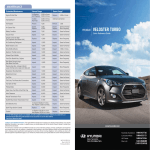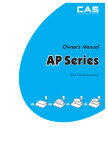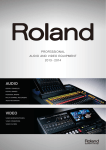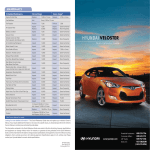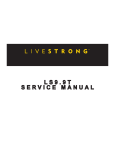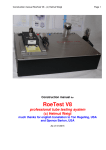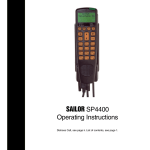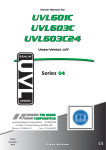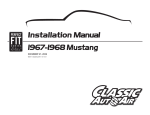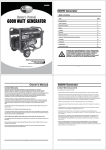Download Classic AutoAir 1971-1973 Mustang A/C system Installation manual
Transcript
Installation Manual © 1971-1973 Mustang DOCUMENT #1-2028 ©2012 ClassicAutoAir / 3.12vs.a CAA 2028 Installation.indd 1 4/2/12 9:57 AM Congratulations... You have just purchased the highest quality, best performing A/C system ever designed for your Classic Vehicle. To obtain the high level of performance and dependability our systems are known for, please pay close attention to the following instructions. Our installation steps and procedures are derived from a long history of research and development and the combined experience achieved thru thousands of successful installations (and feedback from customers like you). Please remember that our #1 goal is that you’ll have a successful installation and a system that performs at a very high level for many years to come. Before starting, read the instructions carefully, from beginning to end, and follow the proper sequence. On the next page you’ll find a safety and general checklist that you should read before starting your installation. Again, thank you from our entire staff. www.classicautoair.com • 866.435.7801 CAA 2028 Installation.indd 3 4/2/12 9:57 AM 4 Check List, Pre-Installation: Before beginning the installation check the shipping box for the correct components. YOUR BOXED UNIT INCLUDES A LIST OF MAJOR COMPONENTS AND A LIST OF BAGGED PARTS. We have a 5 stage check process to make sure you have everything you’ll need. If your vehicle has been or is being modified, some procedures will need to be adjusted to fit your particular application. A basic cleaning of the engine compartment and interior before beginning will make things go more smoothly. Check condition of engine mounts. Excessive engine movement can damage hoses to A/C and/or heater. Before starting, check vehicle interior electrical functions (interior lights, radio, horn, etc). Make a note of anything that does not work as it’s supposed to. During the installation you might find the opportunity to repair or upgrade non-working or out of date components. When you’re ready to start the installation, DISCONNECT THE BATTERY FIRST. Drain the radiator. Retain the coolant and reuse, or dispose of properly. SAFETY FIRST: Wear eye protection while drilling/cutting, deburr sharp edges, and never get in a hurry or force a part. Tools: Your installation only requires the basic tools everyone has in their garage, nothing exotic or specific to A/C or Heat equipment. Procedures, During Installation: Fittings: Use one or two drops of mineral oil (supplied with your kit) on ALL rubber o-rings, threads and rear of bump for o-ring where female nut rides. Do not use thread tape or sealants. Measure twice (or more), cut once Should you have any technical questions, or feel you have defective components (or missing items), call us immediately, we will be glad to assist you. Our toll-free number is listed on every page, we’re here to help! YOU CAN NOW BEGIN THE INSTALLATION... www.classicautoair.com • 866.435.7801 CAA 2028 Installation.indd 4 4/2/12 9:57 AM 5 A Basic A/C Overview OUTSIDE AIR Evaporator with Blower Fan 1 In order to remove the heat from the air in the vehicle, the A/C evaporator allows the refrigerant to absorb the heat from the air passing over it. The blower fan moves cool air out into the car interior. 2 Compressor The compressor pumps and circulates the refrigerant through the system. 3 Condenser The condenser is a heat exchanger mounted at the front of the vehicle. Heat drawn out of the interior of Suction Valve Discharge Valve the car is expelled here. 4 Receiver/Drier The drier not only dries refrigerant, it also filters the refrigerant and stores it under certain Receiver Drier Condenser Compressor operating conditions. 5 High Pressure Switch A pressure switch is used to shut down the system if high or low pressure is detected, basically it acts as a safety switch. Firewall Expansion Valve AIR FROM INSIDE VEHICLE COO LED AIR 1 SUC TIO 3 LIQ UID NH OS HO SE E 2 E ARG ID SCH ER UND Evaporator Unit E HOS COLD AIR INTO VEHICLE 5 4 GRO POW The air conditioning system in your car is comprised of a compressor, condenser, expansion valve, receiver/drier, and evaporator. Refrigerant (also known as Freon) is compressed in the compressor and turns into a gas. In the condenser, this gas is cooled to a liquid state and travels to the expansion valve. As the liquid refrigerant goes through the expansion valve it rapidly cools in the evaporator. A fan blows over the evaporator and cools the air that blows out your vents. The receiver-drier separates gas and liquid. www.classicautoair.com • 866.435.7801 • OVERVIEW CAA 2028 Installation.indd 5 4/2/12 9:57 AM 6 Control & Operating Instructions Your new Perfect Fit-Elite system offers complete comfort capabilities in virtually every driving condition. This includes temperature control in all of the modes. This system also provides the ability to blend the air between Face, Heat, and Defrost modes simultaneously. To illustrate the various ways you can adjust the airflow direction and temperature - we’ve provided these handy illustrations and chart to show exactly how you can adjust your Perfect Fit-Elite for maximum comfort... The FAN switch works like the OEM switch, the DOWN position is OFF (all power to the system is OFF in this position). MODE LEVER There are 11 levels of adjustment within the range of the MODE lever. The COLD/HOT positions works like any traditional adjustment lever. FAN SWITCH NOTE: When the TEMP lever is in the "FULL COLD" position the compressor is ON, no matter what position the MODE lever is in (think of it as a compressor-override function). TEMP LEVER DASH Left Lever Postion Distribution Compressor State 1 Face A/C 100% ON DEF 2 3 4 5 Face 80% Face 60% Face 40% Face 20% Defrost 20% Defrost 40% Defrost 60% Defrost 80% 6 Defrost 100% FLOOR 7 8 9 10 Floor 20% Floor 40% Floor 60% Floor 80% Defrost 80% Defrost 60% Defrost 40% Defrost 20% 11 Floor 100% ON WWWCLASSICAUTOAIRCOMs866.435.7801 CAA 2028 Installation.indd 6 4/2/12 9:57 AM 7 INTERIOR COMPARTMENT 9LTV]L.SV]LIV_*VUZVSLVW[PVUHS -HJPH9HKPVHUK)LaLSHUKZL[[OLT HZPKLMVYYLPUZ[HSSSH[LY ZLLMPN\YL ;OLYLTV]HSVM[OL6YPNPUHS/LH[LY(ZZLTIS`JHUIL HJJVTWSPZOLKI`KPZJVUULJ[PUN[OYLLJVU[YVSJHISLZ6ULPZ H[[HJOLK[V[OL/LH[+LMYVZ[KVVYZLLMPN\YL6ULPZ H[[HJOLK[V[OL;LTWLYH[\YLKVVYHUKVULPZH[[HJOLK[V[OL =LU[/LH[KVVYZLLMPN\YL+PZJVUULJ[[OLLSLJ[YPJHS OHYULZZMYVT[OLHZZLTIS`(SZVYLTV]LH[[HJOTLU[ZJYL^ SVJH[LKPUMYVU[VM[OLHPYPUSL[ZLLMPN\YL FIGURE 1 >OLUYL[HPUPUNWHY[ZP[»ZH NVVKPKLH[VZ[VYLWHY[ZPUH aPWSVJRIHNSHILSLK^P[O GOOD IDEA PUMV^OLYL[OLWHY[ZJHTL MYVTHUK^OH[ZPaL[`WLVM [VVSPZULLKLK[VYLPUZ[HSS*SLHUPUN [OLWHY[ZILMVYL`V\ULLK[VYLPUZ[HSS [OLTPZHNVVKPKLH[VV FIGURE 2 FIGURE 3 FIGURE 4 WWWCLASSICAUTOAIRCOMs866.435.7801 CAA 2028 Installation.indd 7 4/2/12 9:57 AM 8 Remove all 4 nuts around blower (as indicated by arrows to right, on passenger side of firewall). Also disconnect the electrical connector from the blower motor. Cut wires at grommet in firewall. Next, remove the OEM defrost duct and set aside for later modification. DRAIN COOLANT FROM RADIATOR and store safely to reuse or recycle accordingly. Cut heater hose approximately 1” from firewall. Also, to prevent forgetting to refill the coolant when the installation is completed, do not put the cap back into place - instead put the cap to the side and cover radiator hole with a clean rag or something similar (this will help remind you to add coolant before starting the engine at the end of the installation). OEM Heater Unit (Not reinstalled) WWWCLASSICAUTOAIRCOMs866.435.7801 CAA 2028 Installation.indd 8 4/2/12 9:57 AM 9 THESE ARE THE PARTS YOU WILL FIND IN BAG KIT A You will use all of these parts and hardware during the next series of installation steps. Pressure Switch (engine compartment) Ground Ground Ground ECU Thermostat OEM Power Supply Fan Plug &DEOH,QWHJUDWRUV :LUH+DUQHVV 3RZHU6XSSO\ Blower Switch Connection Relay )DFHSODWH6WLFNHU %ORZHU6ZLWFK.QRE %ORZHU6ZLWFK%UDFNHW %ORZHU6ZLWFK 7ZR[6FUHZV 7ZR&DEOH&OLSV NOTE: Illustrations NOT shown actual size WWWCLASSICAUTOAIRCOMs866.435.7801 CAA 2028 Installation.indd 9 4/2/12 9:57 AM 10 Remove The Heater Control Head From The Dash. 1) There are four OEM screws that hold your control head to the dash. Remove and retain these screws. Remove the control head assembly (see figure 7). 2) Remove the OEM blower switch knob. Retain the screw, you will use it again shortly. Remove the control cables and the original blower switch and set aside (these will not be reused, see figure 8). 3) Attach the new blower switch bracket to the top part of the back of the face plate (see figure 9-10), utilizing the OEM screw, and then attach the blower switch to the bracket with the two supplied #6 - 20x3/8" screws. FIGURE 7 (OEM switch not reinstalled) FIGURE 8 Retain this OEM screw FIGURE 9 Retain all the OEM parts that you remove, at least until the installation is completed. GOOD IDEA #6 - 20x3/8" Screws FIGURE 10 WWWCLASSICAUTOAIRCOMs866.435.7801 CAA 2028 Installation.indd 10 4/2/12 9:57 AM 11 Attaching our exclusive cables to the control head is accomplished in three easy steps: Step 1) slide the include cable clips over the ends of the of the EZ Integrators (as shown in figure 11) then, Step 2) attach the integrators to the OEM control head base with the OEM screw you removed earlier, overlapping the cable clamps (see figure 12). Step 3) push the integrator wire ends over the ends of the levers (see figure 13). Once you have completed these steps, you have just one quick task to do before you can reinstall the control head back into the dash. We’ve included a new face sticker that corresponds to the actions of your controls. Make sure the surface is clean and oil free, peel off backing and stick the sticker to the control head face. MODE FIGURE 11 l Contro ontrol TEMP C FIGURE 12 OEM Screw NOTE: The cable clips will overlap and use the same hole and the single OEM screw Plug in the blower switch, and insert the entire harness and control head back into dash opening, resecuring with OEM screws. FIGURE 13 WWWCLASSICAUTOAIRCOMs866.435.7801 CAA 2028 Installation.indd 11 4/2/12 9:57 AM 12 THESE ARE THE PARTS YOU WILL FIND IN BAG KIT B You will use all of these parts and hardware during the next series of installation steps. 7ZR[%ROWV (YDSRUDWRU6XSSRUW%UDFNHW 2QH)UHVK$LU,QOHW%ORFN2II )RXU[7HN6FUHZV 2QH0DOH6SDGH&RQQHFWRU 'HIURVW+HDW'XFW$VVHPEO\ 2QH-&OLS )RXU[3KLOOLSV6FUHZV 2QH:DVKHU Illustrations NOT shown actual size WWWCLASSICAUTOAIRCOMs866.435.7801 CAA 2028 Installation.indd 12 4/2/12 9:57 AM 13 Locate the original wiring harness that supplied power to the original heater motor (these wires were previously cut on the engine side of the firewall). Reaching thru the glove box opening pull these wires out of their grommet. Measure 4” from harness and cut both wires (see figure 15). On the OEM power supply wire attach a 1/4” insulated male spade connector. Within the OEM fuse box upgrade the factory HEATER fuse with a 20 amp fuse (VERY IMPORTANT). 4" Locate the bottom left mounting hole in the firewall that attached the original heater motor. From inside of the vehicle drill a 5/8" dia. hole for the drain tube. TEMPLATE NOTIFICATION! A handy drilling template is included in this manual (example shown in figure 16). CAUTION: On the engine side of the firewall there is a brake line. Be careful not drill through the brake line. It may be necessary to carefully push this line out of the way, securing it a bit lower is usually all that is necessary (see figure 17). FIGURE 15 THIS IS FROM THE INSIDE OF THE CAR! All preliminary modifications to the vehicle are complete. YOU CAN DRILL A SMALL PILOT HOLE IN THIS LOCATION FIRST TECH TIPS WITH A SMALLER DRILL BIT (LIKE 3/16"), THEN PROCEED WITH THE 5/8" BIT ONCE YOU KNOW YOU HAVE CLEAR SPACE. E KE LIN HEATER MOTOR HOLE 1 3/8" RA !B N TIO 5/8" U CA FIGURE 16 You can now begin installing your Classic Air Perfect Fit Elite System. 5/8" HOLE FIGURE 17 WWWCLASSICAUTOAIRCOMs866.435.7801 CAA 2028 Installation.indd 13 4/2/12 9:57 AM 14 Locate the Fresh Air inlet block off. Install over hole in inlet cowl as shown on the passenger side (see figure 18A). Attach with three #10 - 16 x 3/4" Tek Screws. Locate the mounting tab location as shown and attach the 1/4" 20 J-clip supplied (see figure 18B). Install a Fresh Air inlet block off over the vent opening at the drivers-side in the same way, using the four OEM nuts. A Remove evaporator unit from box and place on a flat work surface. Locate defrost / heat duct assembly and attach to the evaporator using two #10 - 10 x 5/8" Phillips screws (see figure 19). NOTE: Be sure that the s-clips are pushed over rear flange on evaporator. B Remove ECU from main unit and set aside. FIGURE 18 Take a minute to familiarize yourself with the evaporator unit: Actuator Motor Blower Motor Bracket Floor/Face Vent Door Evaporator Support Bracket Holes Thermostat FIGURE 19 Blower Motor Plug WWWCLASSICAUTOAIRCOMs866.435.7801 CAA 2028 Installation.indd 14 4/2/12 9:57 AM 15 DASH FIREWALL Installing the complete evaporator unit under the dash will go much easier with the help of a friend. One person can take the unit within the car and “roll” up and under the dash while the other person can be ready at the firewall area with one of the 1/4" - #20 x 5/8" bolts to secure the unit in place (see figure 20). Now the unit will be easy to level and secure. Leveling the unit is very important to insure proper drainage of condensation. On back side of the evaporator is a mounting bracket with a 1/4"-20 J-clip. This bracket will go flush with the inside firewall and you will secure the evaporator by inserting one 1/4" - #20 x 5/8" bolt with a 1/4” washer (from the engine side) using the bottom right hole (that originally attached the original heater assembly, see figure 21). FIGURE 20 LEVEL TECH TIPS Be sure to align the evaporator unit level with the bottom of instrument panel (assuming the vehicle is sitting level) as shown above, but with a small degree of tilt toward the back to allow proper drain of condensation. FIGURE 21 1/4 - #20 x 5/8" bolts and a 1/4” washer WWWCLASSICAUTOAIRCOMs866.435.7801 CAA 2028 Installation.indd 15 4/2/12 9:57 AM 16 The second 1/4 - #20 x 5/8" bolt attaches the blower motor mounting bracket in the same location as the original heater mounting in front of the Air Inlet. The blower support bracket will have an additional hole behind the 1/4 #20 x 5/8" Bolts. Install a #10 - 16 x 3/4" Tek screw through this hole and into the cowling (see figure 22). Locate in the Hardware Sack Kit the Evaporator Mounting Bracket and attach to evaporator unit using two #10 - 10 x 5/8" Phillips screws. Attach other end to the cowling with a #10 - 16 x 3/4" Tek Screw (see figure 23). IMPORTANT NOTE: On the side of the main unit you will see several holes for mounting holes... ONLY USE THE ONES IN THE CENTER FOR THIS BRACKET! Do not tap into the other holes for any reason (see figure 24). Also, use a screwdriver and hand-power and do not over-tighten so you don't strip the holes. FIGURE 22 #10 - 16 x 3/4" Tek Screw NO! YES FIGURE 24 NO! FIGURE 23 #10 x 5/8" Screws WWWCLASSICAUTOAIRCOMs866.435.7801 CAA 2028 Installation.indd 16 4/2/12 9:57 AM 17 THESE ARE THE PARTS YOU WILL FIND IN BAG KIT C You will use all of these parts and hardware during the next series of installation steps. &OHDU3ODVWLF'UDLQ7XEH (OHFWURQLF:DWHU&RQWURO9DOYH 7ZR&DS3OXJV 6L[:RUP*HDU&ODPSV 7ZR[7HN6FUHZV 5HIULJHUDQW7DSH )LUHZDOO%ORFN2II Illustrations NOT shown actual size WWWCLASSICAUTOAIRCOMs866.435.7801 CAA 2028 Installation.indd 17 4/2/12 9:57 AM 18 Water valve hose connects to this connection In Bag Kit C you’ll find the firewall block off. Install this over the hose connections coming thru the firewall within the engine compartment. Attach with two #10 - 16 x 3/4" Tek screws (Figure 25). Seal around the tubes with the included refrigerant tape. This will keep unwanted moisture and debris from entering thru the firewall... so seal carefully and thoroughly. IMPORTANT NOTICE Classic Auto Air has done extensive testing on the correct method to install the water valve in order to get a repeatable and progressive temperature control. The water valve must be installed per these instructions!.... FIGURE 25 The lower connection on the tubes coming thru the block off assembly is going to be routed to the water outlet on the intake manifold. Attach your hose with cable clamps on both ends and route where it will not intefere with linkage or come in contact with exhaust manifolds or headers. This inlet is connected to the intake manifold (5 & 2 5( The upper port coming thru the firewall will be routed to and thru your new your electronic water valve (the water valve is marked for easy installation). First Attach a 6” piece of 5/8” dia. heater hose with the supplied worm gear clamp. Attach to the inlet side of the water valve using another supplied hose clamp. Attach a heater hose from the outlet side of the electronic water valve and route to the connection on the water pump. 3 8 03 $7 (5 +( 7 :$ Insert a 6" piece of the clear, 1/2" drain tube we included through the hole previously drilled and attach over the drain nipple (see figure 26). Seal around tube with refrigerant tape. FIGURE 26 1/2" Clear Drain Tube Refrigerant Tape WWWCLASSICAUTOAIRCOMs866.435.7801 CAA 2028 Installation.indd 18 4/2/12 9:57 AM 19 THESE ARE THE PARTS YOU WILL FIND IN BAG KIT D You will use all of these parts and hardware during the next series of installation steps. CONT WATER VALVE The ECU will be found in it’s own box ROL LOOR FACE/F ST DEFRO POWER )LYH[7HN6FUHZV <HOORZ 2UDQJH %OXH :LUH+DUQHVV6\VWHP Illustrations NOT shown actual size CAA 2028 Installation.indd 19 4/2/12 9:57 AM 20 We’ve included enough wire length to allow you to mount the ECU in a variety of places. It is very important that you mount this in a place where it will stay dry and that vibration is at a minimum. Also make sure that where ever you mount it does not interfere with any moving controls or cables. We recommend mounting it just above the right hand side of the main unit using the included tek-screws. IMPORTANT! DON’T MOUNT THE ECU PERMANENTLY JUST YET. THAT CAN BE DONE AFTER YOU CALIBRATE THE UNIT (SEE NEXT PAGE). In Bag Kit D you will find three wiring harnesses with connections at each end. Plug the harness with YELLOW band into the YELLOW ECU port and the other end into the servo motor on the main unit (motor is marked with YELLOW INDICATOR). Repeat this process for the other two harnesses, following the color coding indicated on cables and ports. Attach cable in the engine compartment to the electronic water valve (see figure 27). Using one of the CAP PLUGS provided, slot it and install over the heater hose/cable. INSTALL (2) 1” dia. CAP PLUGS OVER HOLES. SLOT ONE FOR THE CABLE. FIGURE 27 CONT ROL DEFROS FIREWALL WATER VALVE NOTE: The GREEN harness connection will be made from the harness you previously installed, just plug the loose connection in the CONTROL port on the ECU. T LOOR FACE/F POWER WWWCLASSICAUTOAIRCOMs866.435.7801 CAA 2028 Installation.indd 20 4/2/12 9:57 AM 21 Orang eH arn e Wiring Diagram/Overview To 12V Power Supply Re Electronic Water Valve d /W ss hite Compressor Wi re r G Wh Pressure Switch Ground Wire ite Blower Switch r Ha n ee s ire W e Blu s nes ECU Relay Servo for Defrost Ducts Blu eW ire Thermostat Red Wire ness ire W Blu e Servo for Face/Floor Ducts Blue Har ss r ne Yello w H a Cable Integrators Ground Evaporator Bl ue W ire Ground REMINDER: BE SURE THAT THE WIRING HARNESS DOES NOT INTERFERE WITH THE OPERATION OF ANY CONTROLS. CAA 2028 Installation.indd 21 4/2/12 9:57 AM 22 TEMPORARILY RECONNECT THE BATTERY AT THIS TIME. MODE YOU CAN NOW CALIBRATE YOUR UNIT. CALIBRATION: Before we boxed and shipped your unit, we tested and calibrated it to factory specifications to make sure it is capable of operating at maximum efficiency. However, the unit must still be calibrated to your specific vehicle and controls. This is an easy process that will only take a few minutes. TEMP As you follow thru these steps you’ll be able to hear the motors working on your unit. If for any reason your unit does not calibrate properly the first time, just turn off the unit and rerun the setup process. 1) 2) 4) 5) Insert Calibration Key Move MODE control to the left extreme (DASH) and TEMP control to right extreme (HOT) Power Up Board (turn fan control to MEDIUM) the LED comes ON After 1 second the LED turns OFF After 1 second the LED turns ON B 6) 7) 8) Move MODE control to other extreme (FLOOR) After 1 second the LED turns OFF After 1 second the LED turns ON C 9) Move TEMP control to other extreme (COLD) 10) After 1 second the LED turns OFF 11) After 1 second the LED turns ON A ( ( $/9 (59 :$7 $/9 (59 :$7 \ .H WLRQ OLEUD &D 67 52 '() 17 &2 / 52 & )$ 32 :( () /2 25 / & )$ 52 17 &2 5 32 :( () /2 67 52 '() 25 5 \ .H WLRQ OLEUD &D QUICK NOTE 3) Disconnecting the power (i.e. battery) will not cause your ECU to lose it’s settings. AFTER CALIBRATING, REMOVE KEY AND STORE IN A SAFE, DRY PLACE - ALONG WITH THIS PAGE. 12) The motor calibration starts, one way then the other, then the doors set to midpoint 13) LED turns OFF 14) Turn power to OFF 15) Remove and store calibration key WWWCLASSICAUTOAIRCOMs866.435.7801 CAA 2028 Installation.indd 22 4/2/12 9:57 AM 23 THESE ARE THE PARTS YOU WILL FIND IN BAG KITS E, F, and G You will use all of these parts and hardware during the next series of installation steps. Bag E 'HIURVW$GDSWRU 31 Bag F Bag G 7ZR/RXYHU$GDSWRUV 31 &HQWHU'DVK9HQW 31 7R&HQWHU /RXYHU 7ZR'XFW+RVHV,' &DSSHG XQXVHG 7R'ULYHUV 6LGH/RXYHU 7ZR'XFW+RVHV,' )DFH)ORRU $VVHPEO\ 7R3DVVHQJHU 6LGH/RXYHU )RXU=LS7LHV )RXU=LS7LHV )RXU[µ6FUHZV 7ZR'XFW+RVHV ,' )RXU=LS7LHV Illustrations NOT shown actual size XXXDMBTTJDBVUPBJSDPNtt1"(& WWWCLASSICAUTOAIRCOMs866.435.7801 CAA 2028 Installation.indd 23 4/2/12 9:57 AM 24 Bag Kit E. Locate defrost duct from the heater box to base of the defrost distribution plenum. Use sharp box knife and carefully trim duct assembly flush with flange as shown below. Attach the included defrost adaptor to the duct assembly. Pre-installed S-Clips will hold it in place. Attach flex hoses to the adapter and route to the assembly on the top of the evaporator (see figure 29). The face/floor assembly comes pre-installed with s-clips which allow you to install it onto the evaporator unit quickly and securely (see figure 30). FIGURE 29 FIGURE 30 WWWCLASSICAUTOAIRCOMs866.435.7801 CAA 2028 Installation.indd 24 4/2/12 9:57 AM 25 Attach louver adaptors to the back side of OEM louvers, both sides. S-Clips will hold them in place. Route supplied flex hoses as shown below. Take your time and route them so they don’t become kinked or torn. TECH TIPS During installation of the hoses be aware of the eventual movement of the wiper arm components. Also, the process for installing the center louver vent will require a small amount of cutting. This is outlined on the next page. The smoother the route of the flex hoses the better the airflow. GOOD IDEA OEM VENT During installation of the hoses be aware of the eventual movement of the wiper arm components. Adaptor WWWCLASSICAUTOAIRCOMs866.435.7801 CAA 2028 Installation.indd 25 4/2/12 9:57 AM 26 Bag Kit G: Installing the center louver vent requires some cutting to the upper pocket slot in the center dash area. Your goal is to open the back enough to insert the included center louver unit into the hole and then attach the flex hose. Use a hole drill bit and open it up a bit at a time (see below). Use the new center louver as a guide to see when you’ve cut-away enough material. Once the hole is the right size, insert the new center louver and attach the flex hose using ty-wraps to secure. Route to the face/floor asembly on the evaporator. FIGURE 32 9LTV]L[OPZ HYLHRLLWLKNLZ ZTVV[O GOOD IDEA As you cut the hole thru the dash, keep the new center louver handy and test fit occasionally. WWWCLASSICAUTOAIRCOMs866.435.7801 CAA 2028 Installation.indd 26 4/2/12 9:58 AM 27 You can reinstall the glove box, radio, bezel, facia and the console at this time. This completes the interior portion of the PERFECT FIT-ELITE installation process. This is a good time to make a final check that all the controls still move freely and that nothing is loose or hanging down. The interior of your car should look pretty much the same as before you started (or better). Plus you probably got to know the underside of your dash a lot better and might even have repaired or upgraded components that needed attention. Good Job... Let's move on to the major components within the engine compartment.... If you have any questions before you move on the final phase of this installation, call us. 888.791.6384 WWWCLASSICAUTOAIRCOMs866.435.7801 CAA 2028 Installation.indd 27 4/2/12 9:58 AM 28 THESE ARE THE PARTS YOU WILL NEED FOR THE ENGINE COMPARTMENT INSTALLATION You’ll find all of these parts within the main box /LTXLG7XEH /HIW&RQGHQVHU 8SSHU 31 5LJKW&RQGHQVHU 8SSHU 31 /HIW&RQGHQVHU /RZHU 31 5LJKW&RQGHQVHU /RZHU 3131 'ULHU%UDFNHW 'ULHU /LTXLG7XEH 'ULHUWR(YDSRUDWRU &RQGHQVHU 31 'LVFKDUJH7XEH &RUH6XSSRUW6SDFHU µ R V H Q+ WL R XF )RXU=LS7LHV )RXU[7HN6FUHZV 6SOLFHDQG %XOOHW&RQQHFWRU 3UHVVXUH6ZLWFK %DJRI2ULQJVDQG0LQHUDO2LO7XEH /LTXLG+RVH ' LVFKD UJH+RV H 3UHVVXUH6ZLWFK+DUQHVV 7XEH6XSSRUW%UDFNHW 31 6 7HQ[+H[6FUHZV 7KUHH5HIULJHUDQW+RVHV WWWCLASSICAUTOAIRCOMs866.435.7801 CAA 2028 Installation.indd 28 4/2/12 9:58 AM 29 ENGINE COMPARTMENT INSTRUCTIONS ENGINE COMPARTMENT FIRST THING: IF YOU HAVE NOT DONE SO ALREADY, DISCONNECT THE BATTERY. During the next steps you’ll be installing the condenser, drier, and routing the high/low pressure lines and the liquid line. Since much of this is installed in the OEM location for the condenser, you’ll need to remove the center grill section, and latch support assembly (see figure 33). Be sure to retain all the mounting screws – you’ll reinstall these pieces in the exact reverse order with the OEM screws. FIGURE 33 WWWCLASSICAUTOAIRCOMs866.435.7801 CAA 2028 Installation.indd 29 4/2/12 9:58 AM 30 DRIER AND CONDENSER PREPARATION. You can perform most of the following steps on a clean flat surface like a workbench. Lay the condenser down so that both hose connections are on the right side (the larger connection will be on top). We’ve provided four brackets, 2 upper and 2 lowers, each designed to mounted to the correct side of the condenser. Use the diagram below to install the brackets in the correct places (plus, once you slide the condenser into place in the car, the bolt holes on the brackets will align to the OEM holes in the support, so you can adjust if necessary). Use the #10 x 3/8” screws to mount the brackets to the condenser. TECH TIPS You can easily find the correct position for mounting the drier to the condenser by using the drier liquid tube as a gauge. Install the drier on the right hand side of the condenser. First insert the drier into the drier mounting bracket (it’s basically a sleeve for the drier). Attach the drier liquid tube to the drier and also to the connection on the lower condenser (tighten connections at either end using supplied o-rings on both ends and a few drops of mineral oil to each o-ring). With these two components combined it will easy to find the correct place to attach the drier bracket to the condenser with the included tek screws. Place the condenser into place in the vehicle. Secure brackets to holes in OEM support with included Tek screws. TECH TIPS Reminder... Use two wrenches to tighten o-ring fittings WWWCLASSICAUTOAIRCOMs866.435.7801 CAA 2028 Installation.indd 30 4/2/12 9:58 AM 31 Screw the high-pressure switch into the port at the top of the drier. Plug in harness. Just to the left of the hole that you will route the tubes thru the support is a dimple (see illustration to the right). Drill a 3/16” hole thru the dimple, and mount the included tube support spacer. Locate the Liquid Tube, and the Discharge Tube. Using (1) #6 o-ring and a few drops of mineral oil attach liquid tube to drier and pass through the opening in the radiator core support. Using (1) #8 o-ring and a few drops of mineral oil attach discharge tube to the condenser and pass through the opening. Attach bracket over tubes. Insert screw through bracket, spacer and then through previosly drilled hole. Attach using the #10 nut. Spacer Route wires from high-pressure switch out thru the tube hole and along the discharge tube into the engine compartment. Bracket WWWCLASSICAUTOAIRCOMs866.435.7801 CAA 2028 Installation.indd 31 4/2/12 9:58 AM 32 rS de Fe n CO COMMPLETE PRES KIT SOR tru ts Time to install the compressor kit. Included in your box is a premium compressor kit with all the parts you’ll need to install the compressor. This kit includes instructions specifically written for your engine. Once you’ve installed the complete compressor kit, continue on to connecting the hoses. FIGURE 37 1) Attach the #8 Discharge Hose (13/32") to the connection coming thru the core support and route to the compressor. Tighten fittings using o-rings and mineral oil provided. 2) Attach the #6 liquid hose (5/16") to the connection coming thru the core support and route along the underside of the fender struts, around the engine, and to the connection at the firewall on the evaporator unit (see figure 41). Using supplied zip-ties you’ll attach this hose, the suction hose and the lead from the high pressure switch to the strut braces, securing all three at once. Tighten fittings using o-rings and mineral oil supplied in kit. 3) Attach the #10 suction hose (1/2”) to the compressor and route as mentioned above. Tighten fittings using o-rings and mineral oil supplied in the kit. WWWCLASSICAUTOAIRCOMs866.435.7801 CAA 2028 Installation.indd 32 4/2/12 9:58 AM 33 New A/C System Preparation Please read thru these procedures before completing this new A/C system charging operation. A licensed A/C technician should be utilized for these procedures to insure that your new system will perform at it’s peak, and that your compressor will not be damaged. 1) Your radiator/cooling system is an integral part of your new system. Please insure that you have a 50/50 mix of distilled water and antifreeze. The heater coil MUST be purged (cycle heater control valve) to make sure no water, without antifreeze, is in the heater coil before you charge the A/C system. 2) Evacuate the system for 45 minutes (minimum). 3) Your new compressor MUST be hand-turned 15-20 revolutions before and after charging with liquid. Failure to do this may cause the reed valves to become damaged (this damage is NOT covered by your warranty). 4) Your new system requires 134a refrigerant. It will require 1.5 lbs (or 24 oz). 5) Your new compressor comes charged with oil - NO additional oil is needed. 6) Insure that the new belt is tight. 7) DO NOT CHARGE SYSTEM WITH LIQUID WHILE THE ENGINE IS RUNNING! RECOMMENDED TEST CONDITIONS: (After system has been fully charged and tested for basic operation) • Determine the temperature outside of the car • Connect gauges or service equipment to high/low charging ports • Place blower fan switch on medium • Close all doors and windows on vehicle • Place shop fan directly in front of condenser • Run engine idle up to approx. 1500 rpm ACCEPTABLE OPERATING PRESSURE RANGES: 1. HIGH-SIDE PRESSURES (150-250 PSI) 2. LOW-SIDE PRESSURES (15-25 PSI in a steady state) Centerline of the Oil Plug 90˚ 90˚ CAUTION! When mounting your compressor and/or adjusting the belt, use caution not to tilt the compressor up to or more than 90˚ off the centerline of the oil fill plug. This can cause compressor failure. Do not tilt, shake or turn refrigerant can upside-down OR use a charging station to install refrigerant while the engine is running. Doing so will direct liquid refrigerant into the compressor piston chamber, causing damage to reed valves and/or pistons and/or other components, as well as potentially seizing the compressor. Allow a minimum of 30 minutes for liquid to "boil off.” You must hand turn the compressor hub (not the pulley) a minimum of 15 complete revolutions prior to starting the engine with the clutch engaged. Readings above are based on an ambient temperature of 90˚ with an adequate airflow on condenser www.classicautoair.com • 866.435.7801 CAA 2028 Installation.indd 33 4/2/12 9:58 AM 34 Trouble Shooting Your Classic Auto Air A/C System PROBLEM: system is not cooling properly ISSUE: cold at idle, warmer when raising engine RPM’s Make sure the Water Valve is positioned correctly The water valve is a directional valve and should be installed with the arrow pointing towards the water pump, it should be connected to the heater hose that runs from the heater core to the water pump. If the water valve is connected to the incorrect hose it allows water to circulate through the system via the heater core over powering the cooling effect of the A/C coil, (normally the air conditioning is functioning properly). Step 1: Check placement of the water valve, correct if needed. (In some cases changing the location of the water valve may not fix the above problem.) Continue to next step. Step2 If changing the location of the water valve does not rectify the issue, then possibly the water valve is permenatly damaged and may need to be replaced. To check the integrity of the water valve completely remove the water hoses for the heater core and “loop” together. (This will remove the heater system completely from the possibilities) If the system now cools, replace the water valve Verify Adequate Air Flow to Condenser For an air condiitiong system to function properly there has to be adequate airflow across the condenser. The function of the condenser is to disapate heat, without proper airflow your system will not cool correctly in the cabin of your vehicle. Step 1: connect gauges to a/c hoses. The pressures should be: with the ambient temp is 90, low side pressures should be between 8-25 psi, high side pressures should be between 160-260psi Step 2: IF the low side pressures are normal and the high side pressures are high then there might be an airflow issue, continue to next step. 3. With car still in idle and gages attached, pour water down the front of the condenser. What happens to the pressures? If the paper is held in place you are at least getting some air flow. If the high side decreases during test 2 & 3 then your condenser is not getting enough air which is causing your system to not cool properly. To correct this issue you will need a more powerful mechanical fan. Step 3: Confirm correct Refrigerant charge in System All of our systems should be charged with 24oz or 1.8lbs of R134 Refrigerant only. If overcharged you will need to evacuate the system and recharge with the correct amount.* What measurements mean: Low Temp and High Pressure seem to be equal... You have a malfunctioning expansion valve that is stuck open. High Side is extremely high and Low Side is extremely low (possibly into vacuum)... There is a blockage in the system. Remove hoses and blow compressed air through in both directions. If pressures don’t change its possible that your expansion valve is stuck closed and would have to be replaced. *Compressor Concerns: This is often misdiagnosed as a problem for the system not cooling properly. If you have a noisy compressor it is due to improper charging of refrigerant. An overcharged (more than 24oz or 1.8lbs R134) compressor can cause rattling. If charged with pure liquid there is a high probability you have bent reed valves that are causing tapping sound. To test air flow to Condenser do the following three tests: 1. Place a piece of paper on the condenser with the car in idle and see if paper is held in place. 2. With car in idle, attach gages, and place a large capacity fan in front of the condenser. What happens to the pressures? www.classicautoair.com • 866.435.7801 CAA 2028 Installation.indd 34 4/2/12 9:58 AM 35 TROUBLESHOOTING GUIDE TEST CONDITIONS USED TO DETERMINE SYSTEM OPERATION (THESE TEST CONDITIONS WILL SIMULATE THE AFFECT OF DRIVING THE VEHICLE AND GIVE THE TECHNICIAN THE THREE CRITICAL READINGS THAT THEY WILL NEED TO DIAGNOSE ANY POTENTIAL PROBLEMS). B. CONNECT GAUGES OR SERVICE EQUIPMENT TO HIGH/LOW CHARGING PORTS. C. PLACE BLOWER FAN SWITCH ON MEDIUM. D. CLOSE ALL DOORS AND WINDOWS ON VEHICLE. E. PLACE SHOP FAN IN FRONT OF CONDENSER. F. RUN ENGINE IDLE UP TO 1500 RPM. ACCEPTABLE OPERATING PRESSURE RANGES (R134A TYPE) 1. HIGH-SIDE PRESSURES ( 160-250 PSI ) *Note- general rule of thumb is two times the ambient (daytime) temperature, plus 15-20%. 2. LOW-SIDE PRESSURES ( 06-22 PSI in a steady state). CHARGE AS FOLLOWS: R134A = 24 OZ. NO ADDITIONAL OIL IS NECESSARY IN OUR NEW COMPRESSORS. TYPICAL PROBLEMS ENCOUNTERED IN CHARGING SYSTEMS NOISY COMPRESSOR. A noisy compressor is generally caused by charging a compressor with liquid or overcharging A. If the system is overcharged both gauges will read abnormally high readings. This is causing a feedback pressure on the compressor causing it to rattle or shake from the increased cylinder head pressures. System must be evacuated and re-charged to exact weight specifications. B. Heater control valve installation - Installing the heater control valve in the incorrect hose. Usually when this occurs the system will cool at idle then start to warm up when raising the RPM’s of the motor. THE HEATER CONTROL IS A DIRECTIONAL VALVE; MAKE SURE THE WATER FLOW IS WITH THE DIRECTION OF THE ARROW. As the engine heats up that water transfers the heat to the coil, thus overpowering the a/c coil. A leaking or faulty valve will have a more pronounced affect on the unit’s cooling ability. Installing the valve improperly (such as having the flow reversed) will also allow water to flow through, thus inhibiting cooling. Check for heat transfer by disconnecting hoses from the system completely. By running down the road with the hoses looped backed through the motor, you eliminate the possibility of heat transfer to the unit. C. Evaporator freezing - Freezing can occur both externally and internally on an evaporator core. External freeze up occurs when the coil cannot effectively displace the condensation on the outside fins and the water forms ice (the evaporator core resembles a block of solid ice), it restricts the flow of air that can pass through it, which gives the illusion of the air not functioning. The common cause of external freezing is the setting of the thermostat and the presence of high humidity in the passenger compartment. All door and window seals should be checked in the event of constant freeze-up. A thermostat is provided with all units to control the cycling of the compressor. D. Internal freeze up occurs when there is too much moisture inside the system. The symptoms of internal freeze up often surface after extended highway driving. The volume of air stays constant, but the temperature of the air gradually rises. When this freezing occurs the low side pressure will drop, eventually going into a vacuum. At this point, the system should be checked by a professional who will evacuate the system and the drier will have to be changed. E. Inadequate airflow to condenser - The condenser works best in front of the radiator with a large supply of fresh air. Abnormally high pressures will result from improper airflow. Check the airflow requirements by placing a large capacity fan in front of the condenser and running cool water over the surface. If the pressures drop significantly, this will indicate the need for better airflow. F. Incorrect or inadequate condenser capacity - Incorrect condenser capacity will cause abnormally high head pressures. A quick test that can be performed is to run cool water over the condenser while the system is operating, if the pressures decrease significantly, it is likely a airflow or capacity problem. G. Expansion valve failure - An expansion valve failure is generally caused by dirt or debris entering the system during assembly. If an expansion valve fails it will be indicated by abnormal gauge readings. A valve that is blocked will be indicated by high side that is unusually high, while the low side will be www.classicautoair.com • 866.435.7801 CAA 2028 Installation.indd 35 4/2/12 9:58 AM CAA 2028 Installation.indd 36 4/2/12 9:58 AM OEM HOLE DRILL 5/8’ HOLE THIS IS FROM THE INSIDE OF CAR! 1971-1973 TEMPLATE DRILL 9/32’ HOLE CUT 4” DIAMETER HOLE OEM HOLE





































